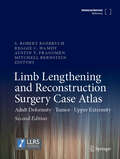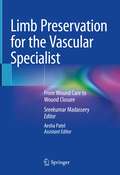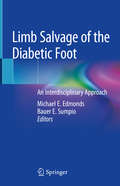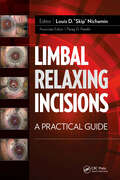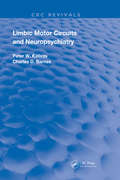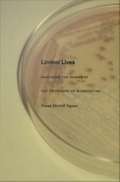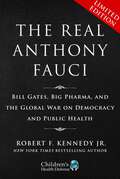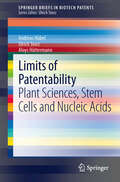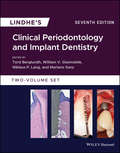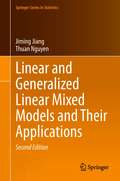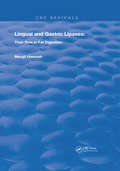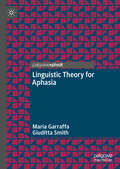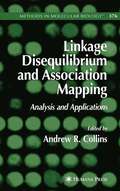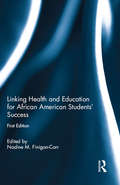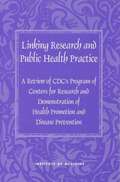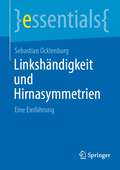- Table View
- List View
Limb Lengthening and Reconstruction Surgery Case Atlas
by S. Robert Rozbruch Reggie C. HamdyConsisting of case studies contributed by both domestic and international leaders in the field, this atlas will be an invaluable resource for all orthopedic surgeons and researchers and practitioners of limb lengthening, deformity correction and the Ilizarov method. Comprehensive yet accessible, it will cover pediatrics, foot and ankle, trauma and post-traumatic reconstruction, adult deformity, tumor and upper extremity interventions in dedicated sections. Each of the unique cases will include color photographs and radiographs from before, during and after surgery and will follow a consistent chapter structure which outlines a brief clinical history of the case, preoperative problem list, treatment strategy, basic principles, technical pearls and how to avoid and manage complications and subsequent problems. Suggested readings round out each case. A comprehensive presentation of techniques will be featured, including external fixation, internal fixation, combination approaches and fully implantable limb lengthening nails. This case-based approach will be an efficient and thorough way to learn this exciting new frontier in orthopedic surgery.
Limb Lengthening and Reconstruction Surgery Case Atlas: Adult Deformity • Tumor • Upper Extremity
by S. Robert Rozbruch Reggie C. Hamdy Austin T. Fragomen Mitchell BernsteinConsisting of case studies contributed by both domestic and international leaders in the field, this second edition of Limb Lengthening and Reconstruction: A Case-Based Atlas remains an invaluable resource for all orthopedic surgeons and researchers and practitioners of limb lengthening, deformity correction and the Ilizarov method. Comprehensive yet accessible, it is sensibly divided into dedicated sections on pediatrics, foot and ankle, trauma and post-traumatic reconstruction, adult deformity, tumor and upper extremity interventions. Each of the more than 450 unique cases includes color photographs and radiographs from before, during and after surgery, and follow a consistent chapter structure that outlines a brief clinical history of the case, preoperative problem list, treatment strategy, basic principles, technical pearls and how to avoid and manage complications and subsequent problems. Suggested readings round out each case. A comprehensive presentation of techniques is featured, including external fixation, internal fixation, combination approaches, fully implantable limb lengthening nails, various techniques of bone transport for skeletal defects, and osseointegration limb replacement surgery. This case-based approach is a time-tested, efficient and thorough way to learn this exciting new frontier in orthopedic surgery.
Limb Lengthening and Reconstruction Surgery Case Atlas: Pediatric Deformity
by S. Robert Rozbruch Reggie C. Hamdy Austin T. Fragomen Mitchell BernsteinConsisting of case studies contributed by both domestic and international leaders in the field, this second edition of Limb Lengthening and Reconstruction: A Case-Based Atlas remains an invaluable resource for all orthopedic surgeons and researchers and practitioners of limb lengthening, deformity correction and the Ilizarov method. Comprehensive yet accessible, it is sensibly divided into dedicated sections on pediatrics, foot and ankle, trauma and post-traumatic reconstruction, adult deformity, tumor and upper extremity interventions. Each of the more than 450 unique cases includes color photographs and radiographs from before, during and after surgery, and follow a consistent chapter structure that outlines a brief clinical history of the case, preoperative problem list, treatment strategy, basic principles, technical pearls and how to avoid and manage complications and subsequent problems. Suggested readings round out each case. A comprehensive presentation of techniques is featured, including external fixation, internal fixation, combination approaches, fully implantable limb lengthening nails, various techniques of bone transport for skeletal defects, and osseointegration limb replacement surgery. This case-based approach is a time-tested, efficient and thorough way to learn this exciting new frontier in orthopedic surgery.
Limb Lengthening and Reconstruction Surgery Case Atlas: Trauma • Foot and Ankle
by S. Robert Rozbruch Reggie C. Hamdy Austin T. Fragomen Mitchell BernsteinConsisting of case studies contributed by both domestic and international leaders in the field, this second edition of Limb Lengthening and Reconstruction: A Case-Based Atlas remains an invaluable resource for all orthopedic surgeons and researchers and practitioners of limb lengthening, deformity correction and the Ilizarov method. Comprehensive yet accessible, it is sensibly divided into dedicated sections on pediatrics, foot and ankle, trauma and post-traumatic reconstruction, adult deformity, tumor and upper extremity interventions. Each of the more than 450 unique cases includes color photographs and radiographs from before, during and after surgery, and follow a consistent chapter structure that outlines a brief clinical history of the case, preoperative problem list, treatment strategy, basic principles, technical pearls and how to avoid and manage complications and subsequent problems. Suggested readings round out each case. A comprehensive presentation of techniques is featured, including external fixation, internal fixation, combination approaches, fully implantable limb lengthening nails, various techniques of bone transport for skeletal defects, and osseointegration limb replacement surgery. This case-based approach is a time-tested, efficient and thorough way to learn this exciting new frontier in orthopedic surgery.
Limb Malformations
by Stefan Mundlos Denise HornOne aim of this atlas is to present a comprehensive overview of limb malformation phenotypes in order to provide the clinician with a tool that facilitates the diagnostic process. With the enormous advances in molecular and developmental biology, the genetic basis of many limb malformations and their relationship to each other has been elucidated. Thus, a further aim of this atlas is to provide the reader with a basic understanding of the molecular pathology of these conditions. The book is extensively illustrated with clinical photos and radiographs of conditions or groups of related conditions. In addition, a concise description of the conditions is provided featuring structured information on "Synonyms", "Major clinical findings", "Genetic transmission", "Differential diagnosis", "Molecular Pathology", and references to Mendelian Inheritance in Man (OMIM). The book is designed for medical geneticists, radiologists, pediatricians, hand surgeons, orthopedic surgeons, as well as medical personnel and other physicians involved in the evaluation and treatment of patients with abnormal limbs.
Limb Malformations: An Atlas of Genetic Disorders of Limb Development
by Stefan Mundlos Denise HornOne aim of this atlas is to present a comprehensive overview of limb malformation phenotypes in order to provide the clinician with a tool that facilitates the diagnostic process. With the enormous advances in molecular and developmental biology, the genetic basis of many limb malformations and their relationship to each other has been elucidated. Thus, a further aim of this atlas is to provide the reader with a basic understanding of the molecular pathology of these conditions.The book is extensively illustrated with clinical photos and radiographs of conditions or groups of related conditions. In addition, a concise description of the conditions is provided featuring structured information on “Synonyms”, “Major clinical findings”, “Genetic transmission”, “Differential diagnosis”, “Molecular Pathology”, and references to Mendelian Inheritance in Man (OMIM).The book is designed for medical geneticists, radiologists, pediatricians, hand surgeons, orthopedic surgeons,as well as medical personnel and other physicians involved in the evaluation and treatment of patients with abnormal limbs.
Limb Preservation for the Vascular Specialist: From Wound Care to Wound Closure
by Sreekumar Madassery Aesha PatelThis book is a comprehensive guide to the essentials of arterial, venous, wound care, and multidisciplinary approaches to prevent major amputation and manage patients with critical limb threatening ischemia (CLTI). Limb preservation has become increasingly prioritized as endovascular techniques, equipment, understanding of multidisciplinary wound care, and other medical treatments have rapidly evolved. Quite often, these patients have CLTI, which is a primarily chronic arterial disease that carries a higher mortality rate than most cancers and cardiovascular diseases. Additionally, complex venous issues contribute to patients losing their limbs, causing significant morbidity to patients and immense cost to the medical system. Many of these patients have diabetes, kidney problems, and hypertension. Due to the advances in the treatment of CLTI and complex venous diseases, medical professionals have been able to decrease major amputations, which cause the higher mortality rate described above. The knowledge of all the approaches, techniques, and management of these patients, however, has been slow to be disseminated.Acting as a structured journey to all aspects of limb preservation, this book begins by covering the basics of understanding wound care patients. This involves beginning wound care management and properly diagnosing the potential underlying processes with non-invasive imaging. From here, clinical pearls and detailed guidance on considering arterial, venous, and lymphatic therapies are covered. Chapters then move into arterial and venous treatment algorithms, from unique to complex approaches, technique tips and tricks, infection and complication management, and future options. Understanding some of the newer approaches such as deep vein arterialization and hybrid surgical approaches is integral in the discussion. Finally, authors cover evaluating the wound post-procedure and long-term, deciding when re-intervention/surgery or amputation (and which type) is needed, and how to tackle the medication management of these complex patients (such as antiplatelets, anticoagulation, diabetes, and nutrition). Chapters are written by a multidisciplinary group of experts, all with an eye towards limb preservation.This is an ideal guide for endovascular specialists, surgeons, podiatrists, infectious disease specialists, and endocrinologists to be able to successfully increase the likeliness of limb preservation for their patients with CLTI and related conditions.
Limb Salvage of the Diabetic Foot: An Interdisciplinary Approach
by Michael E. Edmonds Bauer E. SumpioThis book provides a practical guide to the treatment of patients as risk from limb amputation. The most common presentations of the diabetic foot are presented in concise and evidence-based chapters covering the neuropathic foot, the Charcot foot, the ischemic foot, and the infected foot. Each section includes an introduction to the clinical approach as well as an algorithm illustrating the limb salvage pathway and intervention steps. Limb Salvage of the Diabetic Foot: An Interdisciplinary Approach aims to help the reader build an interdisciplinary understanding of the diabetic foot and its treatment and is of interest to all members of the interdisciplinary diabetic foot team including surgeons, podiatrists, radiologists, nurses, orthotists, infectious disease physicians, and endocrinologists.
Limbal Relaxing Incisions: A Practical Guide
by Louis NichaminFor both surgeon and patient alike, the success of modern implant surgery is increasingly judged by the refractive and astigmatic outcome. In spite of this, there has not yet been a practical book that addresses the process of performing limbal relaxing incisions (LRIs). Dr. Louis D. “Skip” Nichamin and his contributors aim to fill this void with Limbal Relaxing Incisions: A Practical Guide.Limbal Relaxing Incisions serves as a guide for novice refractive implant surgeons looking to incorporate incisional astigmatism surgery into their repertoire. It also contains practical pearls that the more experienced practitioner can use to refine astigmatic refractive outcomes following lens-based surgery.Limbal Relaxing Incisions covers a wide range of information from the history, background, and future of astigmatism management, to important subjects such as measuring cylinder and strategic planning for the surgical correction of astigmatism. Dr. Nichamin and his contributors detail their personal approaches to the use of LRIs, each presenting a slightly different technique and providing simple clinical pearls for both the novice and experienced practitioner. In addition, the book offers a discussion on astigmatic enhancement surgery, potential complications, and insight into the emerging field of Femto-Second Laser technology to further refine and automate astigmatism correction.Residents in ophthalmology, comprehensive ophthalmologists, refractive cataract surgeons, and keratorefractive surgeons taking up lens-based refractive surgery will appreciate the “this is how I do it” approach in Limbal Relaxing Incisions: A Practical Guide, as well as the emphasis on clinical pearls, written by some of the most experienced refractive cataract surgeons in the field.
Limbic Motor Circuits and Neuropsychiatry (Routledge Revivals)
by Peter W. Kalivas Charles D. BarnesPublished in 1993. Limbic Motor Circuits and Neuropsychiatry explores the neural circuitry employed by mammals to interpret environmental stimuli that provoke adaptive behavioral responses. Internationally recognized biomedical scientists have contributed chapters that describe and evaluate the anatomy, physiology, pharmacology, and pathophysiology of how motivationally relevant environmental or interoceptive stimuli are translated into adaptive or maladaptive behavioral responses. The book also examines how classic limbic nuclei communicate with classic motor systems and the implications in neuropsychiatric disorders. This reference presents exciting new information that will interest neuroscientists, psychiatrists, neuropsychopharmacologists, and behavioral pharmacologists.
Liminal Lives: Imagining the Human at the Frontiers of Biomedicine
by Susan Merrill SquierEmbryo adoptions, stem cells capable of transforming into any cell in the human body, intra- and inter-species organ transplantation--these and other biomedical advances have unsettled ideas of what it means to be human, of when life begins and ends. In the first study to consider the cultural impact of the medical transformation of the entire human life span, Susan Merrill Squier argues that fiction--particularly science fiction--serves as a space where worries about ethically and socially charged scientific procedures are worked through. Indeed, she demonstrates that in many instances fiction has anticipated and paved the way for far-reaching biomedical changes. Squier uses the anthropological concept of liminality--the state of being on the threshold of change, no longer one thing yet not quite another--to explore how, from the early twentieth century forward, fiction and science together have altered not only the concept of the human being but the contours of human life. Drawing on archival materials of twentieth-century biology; little-known works of fiction and science fiction; and twentieth- and twenty-first century U. S. and U. K. government reports by the National Institutes of Health, the Parliamentary Advisory Group on the Ethics of Xenotransplantation, and the President's Council on Bioethics, she examines a number of biomedical changes as each was portrayed by scientists, social scientists, and authors of fiction and poetry. Among the scientific developments she considers are the cultured cell, the hybrid embryo, the engineered intrauterine fetus, the child treated with human growth hormone, the process of organ transplantation, and the elderly person rejuvenated by hormone replacement therapy or other artificial means. Squier shows that in the midst of new phenomena such as these, literature helps us imagine new ways of living. It allows us to reflect on the possibilities and perils of our liminal lives.
Limited Boxed Set: Bill Gates, Big Pharma, and the Global War on Democracy and Public Health (Children’s Health Defense)
by Robert F. Kennedy Jr.#1 on AMAZON, and a NEW YORK TIMES, WALL STREET JOURNAL, USA TODAY and PUBLISHERS WEEKLY NATIONAL BESTSELLERPharma-funded mainstream media has convinced millions of Americans that Dr. Anthony Fauci is a hero. He is anything but.As director of the National Institute of Allergy and Infectious Diseases (NIAID), Dr. Anthony Fauci dispenses $6.1 billion in annual taxpayer-provided funding for scientific research, allowing him to dictate the subject, content, and outcome of scientific health research across the globe. Fauci uses the financial clout at his disposal to wield extraordinary influence over hospitals, universities, journals, and thousands of influential doctors and scientists—whose careers and institutions he has the power to ruin, advance, or reward. During more than a year of painstaking and meticulous research, Robert F. Kennedy Jr. unearthed a shocking story that obliterates media spin on Dr. Fauci . . . and that will alarm every American—Democrat or Republican—who cares about democracy, our Constitution, and the future of our children&’s health. The Real Anthony Fauci reveals how &“America&’s Doctor&” launched his career during the early AIDS crisis by partnering with pharmaceutical companies to sabotage safe and effective off-patent therapeutic treatments for AIDS. Fauci orchestrated fraudulent studies, and then pressured US Food and Drug Administration (FDA) regulators into approving a deadly chemotherapy treatment he had good reason to know was worthless against AIDS. Fauci repeatedly violated federal laws to allow his Pharma partners to use impoverished and dark-skinned children as lab rats in deadly experiments with toxic AIDS and cancer chemotherapies. In early 2000, Fauci shook hands with Bill Gates in the library of Gates&’ $147 million Seattle mansion, cementing a partnership that would aim to control an increasingly profitable $60 billion global vaccine enterprise with unlimited growth potential. Through funding leverage and carefully cultivated personal relationships with heads of state and leading media and social media institutions, the Pharma-Fauci-Gates alliance exercises dominion over global health policy. The Real Anthony Fauci details how Fauci, Gates, and their cohorts use their control of media outlets, scientific journals, key government and quasi-governmental agencies, global intelligence agencies, and influential scientists and physicians to flood the public with fearful propaganda about COVID-19 virulence and pathogenesis, and to muzzle debate and ruthlessly censor dissent.
Limited Responsibilities: Social Movements and Criminal Justice (Sociology of Law and Crime)
by Tamar PitchLimited Responsibilities explores the interaction between the criminal justice system and the wider concerns of political and social institutions, including the welfare state, social work and forensic psychiatry. Using the key concept of `responsibility', Tamar Pitch critiques the classical theories of Anglo-American and Italian criminologies, examining the allocation of responsibilities to individuals and society. Looking at the shifting political relationship between criminal justice and the welfare system, Pitch considers the problems which arise in our understandings of responsibility, particularly in relation to the young and the mentally disabled. She also documents the centrality of responsiblity as an issue in women's struggles for legislation on sexual violence, as a paradigm of the politicisation of notions of crime, victimization and criminal responsibility. Limited Responsiblities will be of interest to lecturers, students and professionals in criminology, social policy and women's studies.
Limits of Patentability
by Ulrich Storz Andreas Hübel Aloys HüttermannSpringerBriefs in Biotech Patents presents timely reports on intellectual properties (IP) issues and patent aspects in the field of biotechnology. In this volume the limits of patentability are addressed, a question that is often raised when it comes to biotechnological inventions: The first section addresses current issues in the patentability of plants produced by essentially biological processes including the controversy between farmer's privilege and patent exhaustion with respect to seeds in the US. The second section examines the patentability of human embryonic stem cells in Europe and the US, also considering alternative technologies with respect to their practicability and patentability. The third section focuses on the patentability of genes and nucleic acids, especially the issue of patenting of encoding genes and nucleic acids.
Limpiando las arterias de su corazón
by Carlos L. DelgadoUna guía para vivir mejor. Aquí encontrarás una guía detallada de todos los alimentos que promueven y evitan la inflamación y el uso de probióticos para controlar el colesterol. Finalmente los poderosos rasayanas, mezclas de hierbas para la salud y la longevidad de la antigua medicina de la India, los procedimientos para limpiar los canales obstruidos de tu fisiología y el escudo antioxidante te son explicados con claridad en un programa de 15 días para el logro de este objetivo. Es el momento de empezar una nueva vida ¡YA!
Lindhe's Clinical Periodontology and Implant Dentistry
by Niklaus P. Lang William V. Giannobile Tord Berglundh Mariano SanzDiscover the latest edition of the cornerstone reference on periodontology and implant dentistry that combines scholarship and science with practical clinical instruction The Seventh Edition of Lindhe's Clinical Periodontology and Implant Dentistry brings together a distinguished team of periodontal specialists and academics who deliver another must-have resource for students, researchers, and practitioners specializing in periodontal care and implant dentistry. Seamlessly integrating the foundational science behind periodontology with practical clinical protocols in two comprehensive volumes, the chapters cover anatomy, microbiology, occlusion trauma, pathology, tissue regeneration, treatment planning protocols, infection control, reconstructive therapy, occlusal and prosthetic therapy, and more. The Seventh Edition of Lindhe's Clinical Periodontology and Implant Dentistry: Provides an introduction to anatomy, including periodontal tissues, the edentulous ridge, the mucosa at teeth and implants, and osseointegration Discusses the epidemiology of periodontal and peri-implant diseases Explores the microbiology, including dental biofilms and calculus, periodontal infections, peri-implant infections, the pathogenesis of gingivitis and periodontitis, and the genetic susceptibility to periodontal disease Includes the latest perio- and peri-implant disease classifications Contains updated evidence-based preventive and treatment modalities for the treatment of periodontal and peri-implant diseases Features the latest evidence-based therapeutic alternatives on the use of dental implants to rehabilitate the lost dentition Perfect for postgraduate dental students, researchers, and practitioners specializing in periodontal care and implant dentistry, Lindhe's Clinical Periodontology and Implant Dentistry continues to be the cornerstone reference work on periodontology.
Linear Differential Equations and Oscillators (Mathematics and Physics for Science and Technology)
by Luis Manuel Braga da Costa CamposLinear Differential Equations and Oscillators is the first book within Ordinary Differential Equations with Applications to Trajectories and Vibrations, Six-volume Set. As a set, they are the fourth volume in the series Mathematics and Physics Applied to Science and Technology. This first book consists of chapters 1 and 2 of the fourth volume. The first chapter covers linear differential equations of any order whose unforced solution can be obtained from the roots of a characteristic polynomial, namely those: (i) with constant coefficients; (ii) with homogeneous power coefficients with the exponent equal to the order of derivation. The method of characteristic polynomials is also applied to (iii) linear finite difference equations of any order with constant coefficients. The unforced and forced solutions of (i,ii,iii) are examples of some general properties of ordinary differential equations. The second chapter applies the theory of the first chapter to linear second-order oscillators with one degree-of-freedom, such as the mechanical mass-damper-spring-force system and the electrical self-resistor-capacitor-battery circuit. In both cases are treated free undamped, damped, and amplified oscillations; also forced oscillations including beats, resonance, discrete and continuous spectra, and impulsive inputs. Describes general properties of differential and finite difference equations, with focus on linear equations and constant and some power coefficients Presents particular and general solutions for all cases of differential and finite difference equations Provides complete solutions for many cases of forcing including resonant cases Discusses applications to linear second-order mechanical and electrical oscillators with damping Provides solutions with forcing including resonance using the characteristic polynomial, Green' s functions, trigonometrical series, Fourier integrals and Laplace transforms
Linear and Generalized Linear Mixed Models and Their Applications (Springer Series in Statistics)
by Jiming Jiang Thuan NguyenThis book covers two major classes of mixed effects models, linear mixed models and generalized linear mixed models. It presents an up-to-date account of theory and methods in analysis of these models as well as their applications in various fields. The book offers a systematic approach to inference about non-Gaussian linear mixed models. Furthermore, it includes recently developed methods, such as mixed model diagnostics, mixed model selection, and jackknife method in the context of mixed models. The book is aimed at students, researchers and other practitioners who are interested in using mixed models for statistical data analysis.
Lingual and Gastric Lipases: Their Role in Fat Digestion (Routledge Revivals)
by Margit HamoshFirst published in 1990: This book discusses the role of fat digestion with regards to Lingual and Gastric Lipases.
Linguistic Theory for Aphasia
by Maria Garraffa Giuditta SmithThis book presents a cutting-edge overview of the language models of in phonology, morphology, syntax, and pragmatics, proposed to underlie language phenotypes across aphasic syndromes, as well as the potential applications of linguistic theory to advance therapeutic treatment -and research- in aphasiology. It draws together examples from a range of aphasic syndromes, providing valuable insights into the way language-specific properties may affect the manifestation of language deficits across aphasia. The authors discuss experimental evidence of deficits across language domains, which is crucial to those who study language abilities in aphasia. It concludes by examining how linguistic theory might contribute to patient classification in aphasia and to future directions for research in experimental linguistics and aphasiology. This book will appeal to students and scholars of neuropsychology, psycholinguistics, linguistics, and speech and language therapy.
Linkage Disequilibrium and Association Mapping
by Andrew R. CollinsAs researchers continue to make enormous progress in mapping disease genes, exciting, novel, and complex analyses have emerged. In this book, scientists from around the world, who are leaders in this field, contribute their vast experience and expertise to produce a comprehensive and fascinating text for researchers and clinicians alike. They provide cutting-edge analysis of the most up-to-date and preeminent information available.
Linking Health and Education for African American Students' Success
by Nadine M. Finigan-CarrThe linkages between a student’s health and a student’s ability to learn have been well established. Children who are sick stay home; and, children at home cannot learn if they are not in school leading to increased dropout rates among other educational outcomes. However, an understanding of this concept is just the beginning of understanding how education and public health are inextricably linked. In light of this, Linking Health and Education for African American Students’ Success examines health disparities and education inequities simultaneously and moves beyond a basic understanding of health and education in K-12 school programs. The structural inequalities which lead to reduced academic attainment mirror the social determinants of health. Education is one of the most powerful determinants of health, and disparities in educational achievement as a result of structural inequalities closely track disparities in health. These disparities lead to both sub-standard healthcare and reduced academic attainment among children from underserved minorities in the United States, especially African Americans. This book discusses how this may result in children with poorer mental health outcomes; higher school dropout rates; increased risks of arrests and incarceration; higher rates of chronic diseases and mortality; and overall diminished opportunities for success, while providing suggestions as to how to address these issues. This results in an insightful read for researchers, academics and practitioners in the fields of healthcare and education.
Linking Housing and Services for Older Adults: Obstacles, Options, and Opportunities
by Jon Pynoos Penny Hollander Feldman Joann AhrensPackaging supportive services with housing-a pressing issue for older adultsThe population of older adults is expected to explode in the coming years. Linking Housing and Services for Older Adults: Obstacles, Options, and Opportunities examines a crucial, complex, and often overlooked issue for policymakers and the public at large: older adults&’ increasing needs for housing and supportive long-term care services. As baby boomers strive to help their parents make difficult decisions about their options, pressure mounts for policymakers to develop appropriate housing and services. This book brings together respected experts to discuss the answers to difficult questions about meeting the housing and support service needs of aging adults.Linking Housing and Services for Older Adults: Obstacles, Options, and Opportunities explores in-depth the tough issues pertaining to which populations are presently being served, what their needs are, and who is being left out. You&’ll learn exactly what types of services are available, who is providing them, and how are they packaged. From residential care to assisted living to institutional care, this book addresses all facets of the complicated problems of providing availability to fulfill need. This important source presents insightful analysis of the total range of issues and the challenges to progress as well as offering specific recommendations to effectively offer housing and vital long-term care supportive services to older adults.Linking Housing and Services for Older Adults: Obstacles, Options, and Opportunities discusses in detail: the argument for increased development of supportive housing for older adults-and the barriers preventing it the issues related to providing a variety of housing and service options to the Medicaid population two case studies that illustrate how policies aimed at linking housing and services play out at the state and local level-and the need for strong leadership and the ability to develop key partnerships as vital aspects for success the interrelationship of factors regarding nursing home admission, the availability of subsidized housing, and Medicaid eligibility the need for care management to be holistic-including environmental care assessment, repair, and renovation management in addition to current long-term care settings creating affordable assisted living facilities for older persons receiving Medicaid services the successful components of the national Coming Home Program four case studies emphasizing different finance and regulatory approaches-providing lessons learned for developers, state agencies, and advocates of affordable assisted livingThis vital educational resource is also an essential reference for local, state, and national policymakers, housing officials, and long-term care providers.
Linking Research and Public Health Practice: A Review of CDC's Program of Centers for Research and Demonstration of Health Promotion and Disease Prevention
by National Research CouncilHealth promotion and disease prevention are central priorities in the Centers for Disease Control and Prevention (CDC) vision. To advance research in these areas, Congress authorized and CDC established a program of university-based Centers for Research and Demonstration of Health Promotion and Disease Prevention to explore improved ways of appraising health hazards and to serve as demonstration sites for new and innovative research in public health. Begun in 1986 with three centers, there are now fourteen. In response to a CDC request to evaluate the program, Linking Research and Public Health Practice examines the vision for the prevention research centers program, the projects conducted by the centers, and the management and oversight of the program. In conducting the evaluation, the IOM committee took a broad view of how prevention research can influence the health of communities, and considered both the proximal risk factors for disease prevention and the more distal conditions for health promotion and improved equity in the distribution of risk factors. Month?
Linkshändigkeit und Hirnasymmetrien: Eine Einführung (essentials)
by Sebastian OcklenburgDieses essential gibt einen Überblick über aktuelle Forschung zum Thema Linkshändigkeit und Hirnasymmetrien. Dabei werden neben Grundlagen zur Erfassung von Linkshändigkeit und Hirnasymmetrien auch ihre Evolution, Entwicklung und ihre Erforschung im Tierreich beleuchtet. Weitere Themenschwerpunkte sind die Erforschung zwischen Linkshändigkeit und kognitiven Funktionen sowie das Thema Händigkeit und Sport. Abgerundet wird das essential durch eine Besprechung des Themas Umlernen der Händigkeit und eine Diskussion veränderter Asymmetrien bei verschiedenen Patientengruppen.

